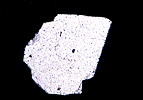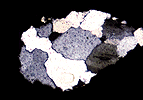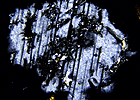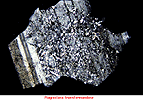
During the transformation of a rock to lead to a soil, the minerals, in contact with the air, and above all with water, alter. On the other hand, the organisms attack the minerals to extract nutrients (K, Ca, Mg, etc.) and they transform the minerals.
The chemical alteration of the original material is widely developed in the soils and the degree and the type of alteration can be assessed by a simple study of any soil sample in the petrographic microscope.
The intensity of the alterations that develop
in the soils can be guessed if the micromorphological features
of a granite rock are compared with those of the soil that forms
from it.

The changes are produced both with regard to the alteration of the mineral grains and to their organisation (structure).
![]() Mineral alteration
Mineral alteration
A crystal of an unaltered mineral has a homogeneous surface, with only one interference colour.

If there are several grains of the same mineral, every grain will show its own interference colour.

If it is a grain formed by the association of several crystals, it will have different colours, but every colour will be unique for every individual crystal.

When the mineral alters, it has a heterogeneous aspect, as if it were dirty, with changes in colour.


Minerals can be altered by means of dissolution

or transform into other minerals.

More extensive information on the mineral alteration in soils can be consulted on these Web: Introduction to the study of soil and Study of sands (both programs in Spanish).